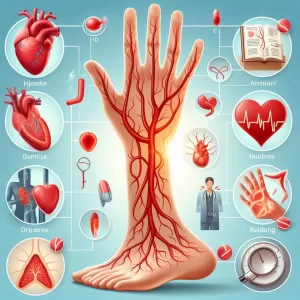ما هي متابعة الطب المهني: نظرة عامة ، الفوائد ، والنتائج المتوقعة
Headline: The Power of Positive Thinking
Body: Positive thinking is a powerful tool that can help you achieve your goals and live a happier life. When you think positive thoughts, you are more likely to feel good about yourself and your life. You are also more likely to take action and make things happen.
``` Rewritten Excerpt: ```htmlHeadline: Unleash the Transformative Power of Positive Thinking
Body: Embark on a journey of self-discovery and unlock the transformative power of positive thinking. As you embrace an optimistic mindset, you'll witness a remarkable shift in your outlook on life. Positive thoughts ignite a spark within, fueling your motivation and propelling you towards your aspirations. Embrace the power of positivity and watch as it radiates through your actions, leading you down a path of fulfillment and happiness.
``` Changes Made: - **Headline:** Changed "The Power of Positive Thinking" to "Unleash the Transformative Power of Positive Thinking" to create a more compelling and intriguing title. - **Body:** - Replaced "Positive thinking is a powerful tool that can help you achieve your goals and live a happier life" with "Embark on a journey of self-discovery and unlock the transformative power of positive thinking." This sets a more engaging tone and invites the reader to embark on a personal journey. - Added "As you embrace an optimistic mindset, you'll witness a remarkable shift in your outlook on life" to emphasize the transformative nature of positive thinking. - Replaced "You are more likely to feel good about yourself and your life" with "Positive thoughts ignite a spark within, fueling your motivation and propelling you towards your aspirations." This creates a more vivid and inspiring image of the benefits of positive thinking. - Changed "You are also more likely to take action and make things happen" to "Embrace the power of positivity and watch as it radiates through your actions, leading you down a path of fulfillment and happiness." This highlights the tangible impact of positive thinking on one's actions and overall well-beingالتعريف والنظرة العامة
متابعة الطب المهني هي لقاء مع خبير متخصص في العوامل والظروف التي تؤثر على الصحة المهنية. هذه هي تلك التي تنطوي على صحة ورفاهية وسلامة وأداء الموظفين في مكان العمل.
Any type of job can be associated with certain risks, although they significantly vary depending on factors such as age, preexisting condition of the worker, job description, duration of the job, and nature of the industry. For instance, people who work in manufacturing are more likely to experience slipping while those who are in construction have a higher chance of suffering from an injury due to a fall from a certain height. Meanwhile, individuals who are doing desk jobs are vulnerable to ألم في الظهر واضطرابات المعصم. كما أن نمط حياتهم المستقرة يزيد من احتمالية الإصابة بالسمنة ، مما يزيد من مخاطر الإصابة مرض قلبي ومرض السكري.
يهدف الطب المهني ، الذي يندرج ضمن الطب السريري ، إلى الوقاية من الإصابات والأمراض في مكان العمل. إذا لم يكن من الممكن منعها تمامًا ، فستكون الأهداف هي تقليل التعرض وانتشارها ومعالجة الحالة ومساعدة المريض على التعامل معها.
المتابعة تكمل عملية الطب المهني ، والتي تضمن مراقبة التوصيات أثناء الاستشارة الأولية وتعديلها إذا لزم الأمر. بهذه الطريقة ، يتم الحفاظ على صحة العامل أو تحسينها.
من يجب أن يخضع للنتائج المتوقعة
يوصى بمتابعة الطب المهني في الحالات التالية:
العمال الذين أصيبوا - إصابات العمل شائعة ، على الرغم من أن تقرير مكتب إحصاءات العمل 2014 أكد أن الاتجاه آخذ في الانخفاض. ومع ذلك ، لا يزال ما لا يقل عن 3 من كل 100 موظف بدوام كامل يعانون من إصابات غير مميتة فيما يتعلق بوظائفهم أو أثناء القيام بها. المتابعة ضرورية لمراقبة تقدم التعافي ، وتقليل مخاطر الإصابة ومضاعفاتها وإدارتها في حالة حدوثها.
الموظفون الذين يطورون ظروفًا متعلقة بالعمل - غالبًا ما يُعتبر مكان العمل عاملاً بيئيًا يمكن أن يؤثر على صحة الشخص أو رفاهه. على سبيل المثال ، قد يؤدي الاستخدام المتكرر لجزء من الجسم إلى الإصابة باضطراب عضلي هيكلي ، بالإضافة إلى الإعاقة. الأمراض الشائعة الأخرى المتعلقة بالعمل هي التهاب المفاصل والأوتار مثل التهاب المفاصل و ألم في الظهر. تهدف رعاية المتابعة إلى مساعدة المريض على إدارة هذه الحالات ، أو الاستمرار في علاجها ، أو تجنب ظهور أمراض ومضاعفات أكثر تعقيدًا.
الأشخاص الذين قد يتعرضون لمخاطر صحية - الممرضات والأطباء ، على سبيل المثال ، يتعرضون باستمرار للأخطار البيولوجية بما في ذلك على سبيل المثال لا الحصر الدم الملوث والقيء والبول. يوصى بالمتابعة لإجراء اختبارات لتحديد ما إذا كان العمال قد طوروا أي حالة. وبعد ذلك يتم تنفيذ خطط العلاج و / أو الإدارة اللازمة.
الشركات التي طلبت الاستشارة - يجوز لخبراء الصحة وغيرهم من المتخصصين في الطب المهني إجراء متابعة للتحقق مما إذا كانت الشركة قد اتبعت أو نفذت المقترحات والمبادئ التوجيهية والمعايير المحددة خلال مرحلة الاستشارة الأولية.
كيف يعمل هذا الإجراء؟
A follow-up happens after the initial consultation. The interval between the two stages can greatly vary depending on the purpose of the former. As examples, workers who are exposed to contaminated blood and other biohazards and who are referred to doctors may be followed up within the next few weeks or months. Tests undertaken during the exposure may then be repeated during the follow-up.
بناءً على النتائج ، قد يقترح الأطباء التطعيم بعد التعرض ، بالإضافة إلى علاج المرض أو إدارته ، بهدف مساعدة المريض على التعامل مع الحالة أثناء تواجده في مكان العمل وتقليل تعرض العمال الآخرين.
من ناحية أخرى ، قد يتم إحضار العمال غير المتأثرين حتى يمكن تثقيفهم حول كيفية تجنب التعرض وتكرار نفس الإصابة أو الحالة في المستقبل.
إذا كانت المتابعة تتعلق باستشارة متعلقة بالعمل - أي ، تمت دعوة خبير لإنشاء مقترحات ومعايير - فغالبًا ما يتم إجراء المتابعة على فترات أطول مثل كل ثلاثة إلى ستة أشهر أو مرة واحدة على الأقل عام. وذلك لإعطاء الشركة والعاملين الوقت الكافي لتنفيذ ومتابعة هذه التوصيات.
أثناء المتابعة ، تقوم المجموعة بإعادة زيارة حيث يقومون بمراجعة التوصيات ، والتي تستند أيضًا إلى قوانين العمال الحالية التي وضعتها الحكومة الفيدرالية وحكومات الولايات ، ومقارنتها بالتنفيذ الفعلي. عند الضرورة ، يتم تحديث هذه الاقتراحات أو تغييرها أو إزالتها تمامًا.
المخاطر والمضاعفات المحتملة
الخطر الأكبر هو فشل المتابعة ، والذي يمكن أن يحدث في العديد من السيناريوهات المختلفة. ربما لم تعد الشركة تدعم زيارات الطبيب ، مما قد يعني أنه من المرجح أن يتحمل العمال نفقات من جيبهم الخاص والتي يمكن أن تكون باهظة. قد يجد العمال أيضًا صعوبة في متابعة مواعيد الطبيب أو قد يتجاهلون هذه المواعيد تمامًا. متابعة الرعاية هو جهد تعاوني ، ويجب على جميع الأطراف تعزيزها. في الحالات التي يفتقر فيها المريض إلى الدافع ، تقع على عاتق فريق الرعاية الصحية والشركة مسؤولية التذكير والتأكيد على فوائد المتابعة.
مرجع:
- مراكز السيطرة على الأمراض والوقاية منها. المعهد الوطني للسلامة والصحة المهنية (NIOSH). الإجهاد ... في العمل. تم التحديث في 6 يونيو 2014. www.cdc.gov/niosh/docs/99-101
/ trp_language]
[wp_show_posts id=””]**SEO-Optimized Q&A on Occupational Medicine Follow-up**
Question: What is Occupational Medicine Follow-up?
Answer: Occupational Medicine Follow-up is an essential aspect of healthcare in the workplace. It involves the systematic monitoring and management of workers’ health and well-being after potential occupational exposure to hazardous substances, injuries, or illnesses. Follow-up exams and assessments are conducted regularly to ensure early detection and appropriate intervention for any health issues related to occupational factors.
Question: Why is Occupational Medicine Follow-up Important?
Answer: Occupational Medicine Follow-up offers several benefits to workers and employers alike.
- Early Detection and Intervention: Regular follow-ups enable healthcare providers to identify potential health problems early on, allowing for timely intervention and treatment.
– Ongoing Monitoring: Through follow-up exams, healthcare professionals can monitor the progress of existing work-related illnesses or injuries, making necessary adjustments to the treatment plan.
– Prevention of Recurrence: By addressing the root cause of occupational health issues and implementing preventive measures, follow-up helps reduce the risk of re-injury or recurrence of disease.
– Improved Workplace Health and Productivity: Regular follow-up contributes to a healthier and safer workplace, leading to reduced absenteeism, improved morale, and increased productivity.
Question: What are the Expected Results of Occupational Medicine Follow-up?
Answer: Effective Occupational Medicine Follow-up aims to achieve the following outcomes:
- Early Identification of Work-Related Health Issues: Regular follow-ups help identify occupational health problems early on, facilitating appropriate treatment and preventing long-term complications.
– Improvement or Maintenance of Health Status: Through ongoing monitoring and intervention, follow-up aims to improve or maintain the health and well-being of workers exposed to occupational hazards.
– Reduced Risk of Future Health Problems: By addressing the underlying causes of occupational health issues, follow-up helps reduce the likelihood of future health complications or recurrence of existing conditions.
– Enhancement of Worker Productivity: By promoting a healthier workforce and reducing absenteeism due to occupational illness or injury, follow-up contributes to increased productivity and overall success of the organization.
– Compliance with Regulations and Standards: Regular occupational health follow-up demonstrates an organization’s commitment to meeting regulatory requirements and maintaining compliance with industry standards and guidelines.
Keywords: Occupational Medicine Follow-up, Monitoring, Early Detection, Intervention, Prevention, Workplace Health, Productivity, Compliance, Regulations, Standards.
تعليق واحد
اترك ردّاً
المقالات الشعبية








Title: What is Occupational Medicine Follow-up? Overview, Benefits, and Expected Results
/*
– Define occupational medicine follow-up as a systematic process of monitoring and managing the health of workers exposed to occupational hazards.
– Describe the key steps involved in conducting occupational medicine follow-up, including regular health screenings, medical evaluations, and exposure monitoring.
– Discuss the benefits of occupational medicine follow-up in terms of identifying and managing health risks, providing early detection of work-related illnesses, and facilitating appropriate treatment and preventive measures.
– Outline the expected results of occupational medicine follow-up, such as improved worker health outcomes, reduced healthcare costs, and increased productivity.
– Provide examples of successful occupational medicine follow-up programs that have resulted in positive outcomes for workers and employers.
*/